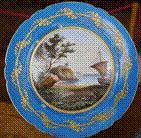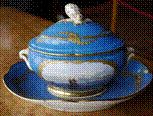Franks Forages No 21

 The French Porcelain
The French Porcelain
The
room folder in use when I first volunteered at Charlecote, described the blue
porcelain as Sèvres. Subsequently it was just
described as French. ‘Foraging’ led me to the French Porcelain society and the
following information was furnished by the secretary, Patricia Ferguson, to
whom I am grateful. (Patricia is also Hon. Advisor on Ceramics to the National
Trust).
It
is a Sèvres-style turquoise-blue ground ‘named’
topographical dessert service, probably from
The scenes are described below. Plates are
left to right looking at the table.
My
thanks to Steph Poyton for assisting me in taking
the photos.
Frank Storr
|
PalaisGhigi Palais
Ghigi is the 17th century ducal palace in the town of |
Hollande
This
scene is just called ‘Hollande’. (It could be in North or South Holland,
two of the 12 provinces that make up the |
|||||||||||||||||||||||||||||||||
 |
 |
|||||||||||||||||||||||||||||||||
|
Chateau
de BellesRuries The
Chateau de Belles Ruries is a 17th century castle in Monnaie
near |
Chateau
de Chaumont This
chateau is in Chaumont-sur-Loire and is a 15th c. building although
an original castle dates from the 10th c. State owned. |
|||||||||||||||||||||||||||||||||
 |
 |
|||||||||||||||||||||||||||||||||
| ‘ | ||||||||||||||||||||||||||||||||||
|
The plates 'Hollande' and 'Chateau de Breda' are what can be described as 'footed dishes'
|
||||||||||||||||||||||||||||||||||
|
‘Vue de Dieppe’ and ‘Chateau de Dieppe’ are comports as shown here. |
||||||||||||||||||||||||||||||||||
|
Breda Castle is situated in North Brabant in the Netherlands. In the 1530s Henry III of Nassau mage extensive alterations to the 13thC fortress. |
||||||||||||||||||||||||||||||||||
|
St.
Malo |
||||||||||||||||||||||||||||||||||
 |
||||||||||||||||||||||||||||||||||
|
Vue de
Dieppe Dieppe is a coastal community in the Haute-Normandie region of northern France famous for its scallops and its pebble beach. |
Chateau
de Dieppe The Chateau de Dieppe is a castle officially classed as a Monument historique. It was founded in 1188, destroyed in 1195 and restored in 1433. |
|||||||||||||||||||||||||||||||||
 |
 |
|||||||||||||||||||||||||||||||||
|
The two sauce boats have a picture on both sides, each depicting a maritime scene. Top left is named as Sicilian coast and top right is the north coast of |Brittany. Bottom left is the sea of Iriose to the west of Brittany and bottom right is the Black Sea.
|
||||||||||||||||||||||||||||||||||
Frank would welcome comments and any additional
information you may have on ‘Frank’s Forages’. Contact him by email on n.splurge@btinternet.com
You can also leave comments in the Tuesday Day Leader’s pigeon
hole.


 Chateau de Breda
Chateau de Breda



